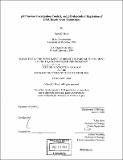| dc.contributor.advisor | Tyler Jacks. | en_US |
| dc.contributor.author | Boyd, Scott D. (Scott Dexter), 1970- | en_US |
| dc.contributor.other | Massachusetts Institute of Technology. Dept. of Biology. | en_US |
| dc.date.accessioned | 2006-03-24T18:16:48Z | |
| dc.date.available | 2006-03-24T18:16:48Z | |
| dc.date.issued | 2004 | en_US |
| dc.identifier.uri | http://hdl.handle.net/1721.1/30070 | |
| dc.description | Thesis (Ph. D.)--Massachusetts Institute of Technology, Dept. of Biology, 2004. | en_US |
| dc.description | "February 2004." | en_US |
| dc.description | Includes bibliographical references. | en_US |
| dc.description.abstract | The experiments presented in this thesis use mutation analysis, and study of the cells of mice with a deletion allele for the Trp53 gene, to explore both the regulation of p53, and its downstream functions mediated by specific activation of target genes. Chapter 2 addresses the regulation of nuclear localization of the p53 protein. Previous reports in the literature had suggested that the p53 negative regulator HDM2 was a nucleocytoplasmic shuttling protein that binds and carries p53 from the nucleus of the cell to the cytoplasm where it is destroyed by the proteasome. We determined that HDM2 with a mutated nuclear export sequence was still able to able to alter p53's cellular localization to a cytoplasmic pattern. The nuclear export sequence in the p53 C-terminus was required for this activity, as was the ability of HDM2 to ubiquitinate p53. Further studies indicated that ubiquitination of the p53 C-terminus was the basis for HDM2's ability to remove it from the nucleus and cause its efficient degradation. C-terminal ubiquitination causes the p53 nuclear export sequence to be activated or made more accessible to the nuclear export machinery of the cell. Chapter 3 summarizes cDNA microarray experiments in which Trp53-/- and Trp53+/+ fibroblasts were treated with a panel of genotoxic agents, and assayed for p53-dependent upregulation or downregulation of the approximately 15,000 gene sequences represented on the microarray. New candidate p53 target genes were revealed, among them the DNA repair gene ErccS, which encodes the xeroderma pigmentosum disease gene homolog Xpg, a participant in nucleotide excision repair and a mediator of base excision repair of oxidative DNA damage. | en_US |
| dc.description.abstract | (cont.) Further analysis of most of the DNA repair genes in the mouse genome using real-time PCR indicated that a second gene, Polk, encoding the translesion DNA polymerase kappa, is also a p53-induced gene. Chapter 4 describes further characterizes the p53-dependent regulation of Ercc5, and shows that it is a directly-regulated p53 target gene with a p53-responsive site in its first intron. TrpS3-null cells show a modest reduction in the ability to repair an oxidatively-damaged DNA construct, and this defect is rescued by exogenous expression of retrovirally transduced XPG, indicating that the lower levels of this gene are likely responsible for the defect. | en_US |
| dc.description.statementofresponsibility | by Scott D. Boyd. | en_US |
| dc.format.extent | 240 p. | en_US |
| dc.format.extent | 8892755 bytes | |
| dc.format.extent | 8892318 bytes | |
| dc.format.mimetype | application/pdf | |
| dc.format.mimetype | application/pdf | |
| dc.language.iso | eng | en_US |
| dc.publisher | Massachusetts Institute of Technology | en_US |
| dc.rights | M.I.T. theses are protected by copyright. They may be viewed from this source for any purpose, but reproduction or distribution in any format is prohibited without written permission. See provided URL for inquiries about permission. | en_US |
| dc.rights.uri | http://dspace.mit.edu/handle/1721.1/7582 | |
| dc.subject | Biology. | en_US |
| dc.title | p53 nuclear localization control, and p53-dependent regulation of DNA repair gene transcripts | en_US |
| dc.type | Thesis | en_US |
| dc.description.degree | Ph.D. | en_US |
| dc.contributor.department | Massachusetts Institute of Technology. Department of Biology | |
| dc.identifier.oclc | 55635726 | en_US |
